
The 1885 Morgan dollar is an exciting piece of American numismatic history, sought after and coveted by collectors for its richness of design, purity of silver, and rich history. The coin was produced in several mints like Philadelphia and Carson City, and even a century into numismatics, the coin is a standout.
If you're trying to find the worth of the 1885 silver dollar, you're part of the club. Grade, mint marks, and rarity all play a role in prices. You need to be aware of your coin's market value. This article gives you the up-to-date facts as of July 2025.
The worth of the 1885 Morgan dollar depends immensely on its mint mark, grade, and whether it is special or rare or in mint state. While circulated coins in normal categories may cost between $30 and $30–$70, mint-state or special coins can command a four-digit figure or tens of thousands in an auction.
The 1885 Morgan silver dollar was made by the Philadelphia, Carson City, New Orleans, and San Francisco mints. The rarest of these is the 1885-CC, with only 228,000 produced, and thus it is highly prized by coin collectors and will command thousands in cost.
The condition of a coin, i.e., milled to mint state, plays a big role in determining its value. Coins in the circulating condition could cost $30 to $70, but uncirculated or mint-state ones could cost hundreds to even thousands of dollars based on good state or high grading.
The rest of the scarce coins include proof coins, prooflike or deep mirror prooflike (DMPL) strikes, and error coins. There were only 930 proof coins minted in 1885. They range from $1,375 to over $60,000, depending on grade.
The 1885 Morgan dollars are bought by collectors on the basis of eye appeal, grade population, and scarcity. Those with greater surface marks, less luster, and shallow strikes are less valuable, especially in the case of rare mint marks, and therefore less valuable in the market.
The 1885 Morgan silver dollar is one of the old coins in the renowned Morgan series, which was designed by George T. Morgan. Four American mints produced this variation, and all types are valuable on their own depending on mintmark, rarity, and grade. The majority of coins spent decades in repositories.
Philadelphia mintage was more than 17.7 million, which is the largest for any 1885 Morgans. They have no mint mark and are most abundant. There were lots on hand in government vaults, so they're plentiful in circulated and uncirculated condition at relatively low costs and thus collectible.
Of 9.18 million coins produced, the New Orleans 1885 Morgan dollar carries an "O" mint mark on the back. There was a huge amount still languishing in Treasury vaults as recently as the 1960s, and uncirculated 1885-O coins are consequently relatively easy for collectors to find even in advanced grades.
San Francisco struck 1.497 million pieces in 1885, all of which have an "S" mint mark. They are less rare than Philadelphia or New Orleans strikes, particularly in upper-grade mint-state. High-grade 1885-S coins are valuable among collectors and fetch much more money in the marketplace.
The 1885-CC Morgan dollar is this kind of rarity in that only 228,000 were produced. Graded "CC," it's one of the more expensive of the Morgan dollars. In lower grades, even 1885-CCs have healthy premiums because of their low mintage and small number of coins in existence.
Mint marks are on the back top of the "D" and "O" of "DOLLAR\". They help identify the origin and value of a coin. No mark = Philadelphia, "O" = New Orleans, "S" = San Francisco, and "CC" = Carson City—each with rarity and price impacts.
The worth of an 1885 Morgan silver dollar is not uniform among individuals. Various determinants—namely, mint mark, rarity, condition, price of silver, and special varieties—determine what one receives. Below is how all of these important determinants contribute to price.
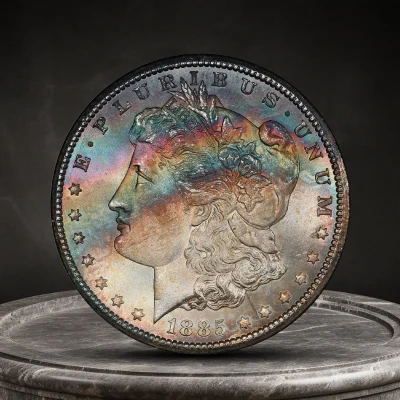
Mint marks have a tremendous influence upon rarity and value. The 1885-CC Morgan dollar with only 228,000 struck is rare and fetches a premium. San Francisco coins are also rare.
Philadelphia and New Orleans, however, struck millions, and thus they're abundant in circulated grades but still fetch good money in high-grade uncirculated conditions, particularly if well-preserved or graded by official services.
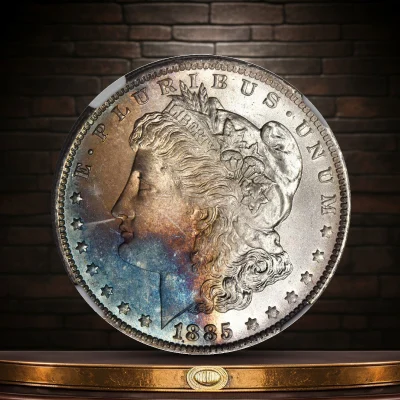
Grades do make a difference. Coins are graded out of 70 points, MS-60 and higher being uncirculated. Circulating coins sell for $30–$70, while mint-state specimens can sell for hundreds.
A spotless MS-68 1885 Morgan sold for $39,950, demonstrating how strong grades with little bag marks command high prices at auction.
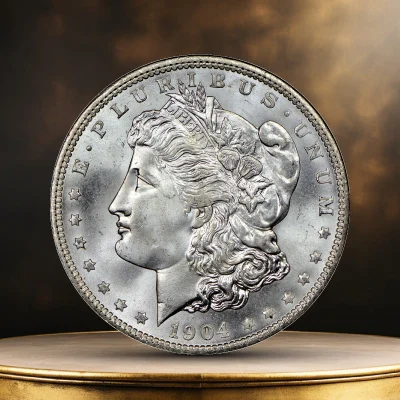
Every Morgan silver dollar has 0.7734 troy oz of actual silver. As the price of silver rises, low-grade coins also receive better melt value (about $19–$20 with silver at $25/oz). While most of them sell at a premium to melt based on collector demand, fluctuations in bullion can still affect base-level pricing on common or worn coins.
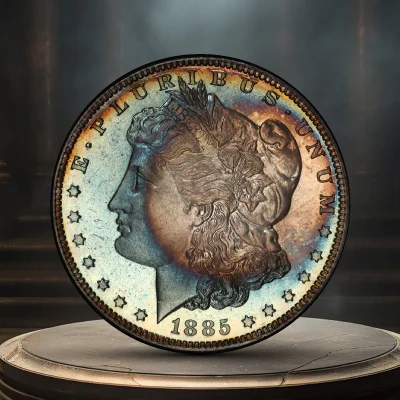
The 1885 proof Morgan dollars (only 930 were struck) were created as a novelty and are very valuable. The coins are proof with mirrored surfaces and very detailed strikes. Prices start at around $1,400 and go up to over $60,000 for high-grade cameo or deep cameo types, and some auction prices approach over $90,000 depending on rarity and perfection.

While the 1885 Morgan is not renowned for glaring mistakes, minor irregularities do exist. Special VAM varieties or striking errors, such as the 1885-O "strikethrough" error, sold for approximately $200.
Such errors do not command enormous premiums but bring novelty. Forgeries are a greater issue—weight check (26.73g) and the authenticity of the design in depth.
The 1885 Philadelphia Morgan dollar had the year's highest mintage—more than 17.7 million pieces. Although abundant, it still retains decent collector demand. Circulated examples will bring many times the melt value, and high-grade uncirculated examples—particularly clean ones—will bring thousands because of their rarity and condition of preservation.
| Grade | Description | Estimated Value (USD) |
|---|---|---|
| G-4 (Good) | Heavily worn, details faint | $32 |
| XF (Extremely Fine) | Light wear on high points | $65–$70 |
| MS-60 (Uncirculated) | Entry-level Mint State with moderate marks | $75 |
| MS-63 | Average uncirculated, decent luster | $125–$160 |
| MS-65 | Strong luster, minor bag marks | $200–$300 |
| MS-67 | Superb strike, almost flawless | $1,500–$3,000+ |
| MS-68+ (Finest Known) | Top-graded known specimen, nearly perfect | $39,950 (auction) |
Collector Tip:
Original surfaces, not cleaned, and no bag marks contribute a huge amount of value. Check Liberty's cheek for smoothness—a critical test of condition. Cleaned coins can lose half their value, so originality is the secret to getting the most from your 1885 Morgan silver dollar.
The 1885-CC Morgan dollar is the star of the 1885 set. It produced only 228,000, and it's the year's lowest-mintage coin and one of the lowest-mintage Morgans ever. Its rarity and historical significance make it one of the hottest and most valuable coins in all grades.
| Grade | Description | Estimated Value (USD) |
|---|---|---|
| G-4 (Good) | Heavily worn but identifiable | $560–$600 |
| F-12 (Fine) | Moderate wear, most details visible | $625–$700 |
| XF (Extremely Fine) | Light wear, strong detail | $800–$1,000 |
| AU (About Uncirculated) | Slight wear on high points, near mint-state | $1,100–$1,300 |
| MS-60 (Uncirculated) | Entry-level Mint State | $1,400+ |
| MS-64 | Excellent luster, minor bag marks | $1,500–$1,800 |
| MS-65 | Strong eye appeal, very few marks | $1,800–$2,200+ |
| MS-68 (Rare Top Grade) | Near flawless, ultra-gem quality | $50,000–$80,000 (estimated) |
Collector Tip:
The 1885-CC Morgan is worth its rarity, low mint condition, and Carson City historical significance. Mint state coins have quantities due to the GSA Hoard release. Purchase only PCGS or NGC-certified coins to guarantee genuineness, since CC mint mark fakes abound. Grade and originality push serious price increases.
The 1885-O Morgan silver dollar was produced with a large mintage of more than 9.1 million coins, but most were dated decades later when certified in the 1960s, so many remain uncirculated. Common as it is, particularly in Mint State, the 1885-O offers great value to collectors, particularly in prooflike (PL/DMPL) finishes.
| Grade | Description | Estimated Value (USD) |
|---|---|---|
| G-4 to F-12 | Heavily to moderately worn | $30–$40 |
| XF (Extremely Fine) | Light wear, strong details | $60–$70 |
| AU (About Uncirculated) | Nearly mint condition, slight wear | $70–$85 |
| MS-60 to MS-62 | Basic Mint State, minor marks | $70–$100 |
| MS-63 to MS-64 | Better luster, improved strike | $120–$175 |
| MS-65 (Gem) | Strong strike, nice eye appeal | $250–$350 |
| MS-67 (Top Grade) | Near flawless, very rare | $1,500–$2,500+ |
| PL/DMPL Coins (MS-63–67) | Prooflike or Deep Mirror coins—high demand | $110–$12,500+ (DMPL MS67) |
Collector Tip:
The 1885-O is relatively inexpensive in uncirculated grades and a good buy for collectors. Weak strikes are common on New Orleans coins, particularly on the chest of the eagle and the hair of Liberty. Strong strikes and clean cheeks are the best value. Prooflike specimens are sought after and will significantly enhance value, particularly if certified.
The 1885-S Morgan dollar is a semi-key date because of its low mintage of 1.497 million and limited presence in high grades. It was unlike the 1885-O, as the majority of 1885-S coins circulated. Mint State coins in their original condition are scarce and highly priced, particularly in MS65+, where they can sell for four- or five-figure figures.
| Grade | Description | Estimated Value (USD) |
|---|---|---|
| G-4 to F-12 | Heavily worn to moderate wear | $37–$100 |
| VF (Very Fine) | Light detail wear, readable features | $100–$150 |
| XF (Extremely Fine) | Light wear, near full detail | $200–$250 |
| AU (About Uncirculated) | Slight wear on high points, attractive coin | $275–$350 |
| MS-60 to MS-62 | Lower Mint State, some bag marks | $400–$550 |
| MS-63 to MS-64 | Good eye appeal, light abrasions | $700–$950 |
| MS-65 (Gem) | Sharp strike, minimal marks | $2,000–$2,200 |
| MS-67 (Top Grade) | Near-perfect, ultra-rare | $50,000–$60,000 (if available) |
Collector Tip:
The 1885-S is in scarce condition—not uncommon, but uncommonly nice. Lots of coins are heavily bag-marked, particularly on Liberty's cheek. If you have a clean, uncirculated one, it's worth submitting to be graded. Even lightly circulated ones (XF, AU) are worth more than usual 1885 dates.
Inspect the hair of Liberty above the brow and ear. Blunted characteristics and smooth cheeks are signs of wear. Glossy strands and tiara leaves are XF or MS grades.
Inspect the chest of the eagle—full feather detail = Mint State, smooth = wear. Inspect talons and wingtips; flat spots lower grade significantly.
Grading from Good (very worn) to MS (uncirculated). Small grade jumps (e.g., MS64 to MS65) have large increases in value, particularly for scarce mintmarks such as 1885-CC or 1885-S.
Don't clean coins—artificial shine or hairline scratches reduce value. Natural patina or toning is preferable. Even tarnished coins are worth more than cleaned or damaged coins.
Services such as PCGS, NGC, or ANACS both authenticate and provide an authorized grade with an endorsement. This enhances resale value and the buyer's assurance, particularly with rare or high-grade Morgans.
Utilize photo-grade guides and emphasize high points to contrast. With experience, you will more accurately estimate slight differences between circulated and uncirculated grades, such as XF45 versus MS62.
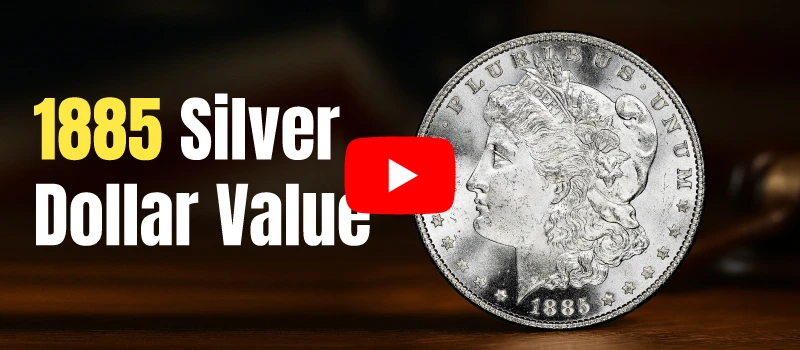
The 1885 Morgan silver dollar possesses the historic popularity, bullion value, and collector demand one looks for in a solid long-term investment. Value is determined by rarity, condition, and time.
Morgan dollars are very liquid because they have broad collector appeal. The series 1885, particularly 1885-CC, is always sought after and has numismatic value coupled with silver content that provides for strong resale value.
Investors have to decide between low-grade rare coins and high-grade non-rare coins. An 1885-CC Fine has the same value as an MS65 1885-P—both have varying potential for appreciation.
Morgan dollars are 90% silver, so they are worth something in and of themselves. Their age and enduring collector demand cause them to hold value even in times of economic recession, usually keeping up with inflation in the long term.
The 2025 coin market is stable. High-grade Morgans and prime dates are increasing in value. Make sure to research current auction sales and price guides when purchasing or selling valuable 1885 Morgan dollars.
Investors are better off opting for quality over quantity. A single high-quality coin will outperform a set of battered ones in long-term value and appreciation, and market worth. Rarity and visual appeal generate collector demand and price appreciation.
Investment worth is maintained with proper storage. Utilize holders, minimize direct handling, and ensure valuable coins. Store certificates and grading details—they guarantee authenticity and increase resale assurance and worth.
The 1885 Morgan dollar is an ageless addition to numismatic history, prized for its silver value, scarcity, and collector value. Whether the Carson City issue or the Philadelphia strike, more plentiful, both denominations are worth something based on mint mark, grade, and originality. High-grade specimens, particularly certified ones, keep appreciating.
To collectors and investors alike, the 1885 Morgan dollar is both physical silver riches and mental charm of America's monetary past. Store safely, buy wisely, and invest in authenticity so your coin holds—and increases—in value for future generations.
A: Circulated 1885 Morgans are $30–$70, while uncirculated ones begin at $75. High grades (MS65+) are hundreds or thousands of dollars. Rarities 1885-CC are $500–$80,000 based on grade for extreme rarity and collector demand.
A: With only 228,000 struck and with great collector demand, the 1885-CC is very rare. It's the final Carson City Morgan and retails for hundreds in circulated and thousands in uncirculated—a date of historical significance with classic Western legend.
A: Flip the coin to the eagle side. Look above the “D” and “O” in “DOLLAR.” You’ll see “O”, “S”, or “CC.” No mark means Philadelphia. The “CC” mint mark is especially rare and valuable.
A: Every 1885 Morgan dollar is 0.77344 troy ounces of pure silver (approximately 24.06 grams). The entire coin weighs 26.73 grams and is 90% silver. Its value by silver content always provides some melt value, independent of collector value.
A: There are no well-known errors, but there are minor VAM varieties and the erratically occurring strike-through error. These do not significantly affect value unless slabbed. Eye appeal, grade, and mint state form the basis for value, not variety or oddity rarity.
A: Flip the coin (26.73g), measure the size (38.1mm), perform a magnet test (will not adhere), and look at the details. Genuine coins ring out clearly. PCGS/NGC grading promises authenticity. Steer clear of suspiciously low-priced or strangely detailed coins—counterfeits abound.
A: Never clean collectible coins. Cleaning diminishes value, wastes original surfaces, and results in obvious damage. Collectors prefer natural toning. Gently rinse if absolutely necessary with soap only. For best preservation, store uncleaned or consult professional conservation advice.
A: Yes—1885 Morgans are silver, old, and sought after. Rarities such as 1885-CC appreciate over the long term; low entry-point common dates are available. Purchase graded coins, learn about grading, and collect—investment return occurs with time, knowledge, and intelligent purchasing.
A: Unlike little pennies, 1885 Morgans are heavy, silver-rich, and historic. They cost more than a nickel or a cent but are worth it. Of all Morgans, 1885 is mid-grade, with 1885-CC being the most significant. They give more history than today's silver bullion.